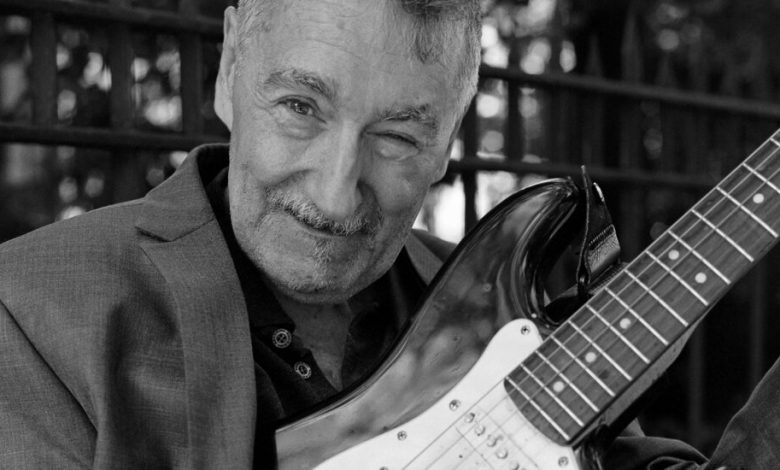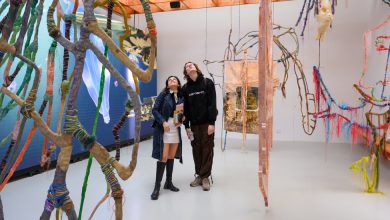The Remarkable, Resilient Loren Connors

If Loren Connors was going to get to his gig, the guitarist knew he would need to crawl. It was late January 2007, two months after he had smashed into a Brooklyn sidewalk and broken his hip while carrying an armload of art, resulting in major surgery and an 11-day hospital stay.
But he had agreed to rally for a concert organized by his record label two miles from his apartment, improvising with a trio he’d never met. After all, this was his life now: Diagnosed with Parkinson’s disease 16 years earlier, he expected the falls and concomitant broken bones to escalate.
After a lift from a friend, there was just one unexpected hurdle on that winter night — 16 steep stairs leading to the venue, tucked inside a silo alongside the Gowanus Canal. “Loren got on his hands and knees and started crawling up,” Eric Weddle, the founder of Family Vineyard, said by phone. Weddle started his label in part to issue Connors’s music, and now he stood at the top of the stairs, dumbstruck. “His laundry list of injuries is crazy, but none of this has stopped him. It isresilience.”
Connors, 72, can barely cross a room now. The pills he takes a dozen times each day often steal his speech until he can only stutter; even on good days, the syllables blur together. His legs kick at night, and he is mostly confined to the cramped Brooklyn Heights apartment he has shared with his partner, the singer and lawyer Suzanne Langille, since 1990.
“Parkinson’s is a curse,” he said on his landline early one recent morning, when his speech is typically best. “It doesn’t kill you, but it just makes your life terrible. I’m hanging in there.”
He is hanging in there, to some extent, because he can still play guitar and paint, both of which he does most days. In the three decades since his diagnosis, he has released about 100 records — gentle suites of forlorn melodies, relentless spans of plangent notes, and, most recently, sprawling drifts of ghostly tones.
This is one of the most productive periods of his career, too, as a confederation of labels rushes to reissue his rarest albums, which often fetch hundreds of dollars online, and to distribute new recordings. During the last year, Connors has shared live collaborations with Sonic Youth’s Kim Gordon and the Australian experimental impresario Oren Ambarchi, plus a book of impressionistic flower sketches. “Airs,” a quiet 1999 collection of gorgeous and brief pieces, will be reissued Friday, with another art book and at least a half-dozen other records due in the next year.
“It’s a passion and a compulsion — he has to create all the time,” Langille said by phone. “And he’s still doing it with all this weight on his back. It comes down to his determination, courage.”
Connors grew up in New Haven, Conn., born to the opera singer Mary Mazzacane and the inventor Joe Mazzacane. The family of five wobbled at poverty’s edge — “shanty Irish,” Connors quipped. He developed a reputation as a rapscallion, less interested in school than drawing, the guitar and rowdy misadventures into New York.
In 1975, after an unhappy — if artistically inspiring — year at the University of Cincinnati, he became a janitor at Yale. For a decade, he lived rent-free in a warehouse crammed with 20 artists, the smell of paint and shellac commingling with fumes from plastic melted by a businessman making toys. (With no family history of Parkinson’s, Connors believes his exposure to these toxins ultimately led to his disease.)
Connors had fallen hard for acoustic blues and electric guitarists like Jimi Hendrix and Eric Clapton, still a favorite. (“All my avant-garde friends don’t like Clapton, because he’s a pop star,” he said. “He’s more than that.”) He ran an art gallery and hosted shows by visiting musicians. In the late ’70s, he began self-releasing a series of splenetic improvisations that suggested the blues broken into bits following a violent car crash. “The reception was absolutely terrible,” Connors said by video call soon after sunrise on a September morning, Langille laughing to his right. “Everyone thought I was a real weirdo — pretty discouraging.”
Actually, not everyone: Connors often cleaned the office of the Southern culture scholar William Ferris, who learned that his janitor had taken the job in part to access Yale’s voluminous library. Connors began sending him those early recordings, and Ferris offered his academic imprimatur via liner notes. “It crossed so many boundaries, redefined the blues in a very modernist way,” Ferris said in an interview. “He taught me where the roots music I loved was moving and wrote a new chapter in American music.”
He found another convert in Langille, a recent Yale Law grad mesmerized the moment she saw him sit at a piano to improvise with a saxophonist in 1984. He loved the intensity of her eyes; she loved, as she put it, that “the whole composition was in him from the first note, just flooding out.” Two years later, they had their only child, Jamie. Four years after that, Connors quit his paper route, his final job apart from art. The trio moved into their 600-square-foot apartment in Brooklyn Heights in 1990 so Langille could work as a public lawyer, arguing against incinerators and advocating for wetlands.
For Connors, the move fulfilled a lifelong goal he’d never been able to afford. New York became his wellspring. After Langille headed to work, Connors and Jamie would make daily pilgrimages over the Brooklyn Bridge to explore Hell’s Kitchen or Five Points. They’d spend hours at the library, researching Connors’s Irish heritage, the city’s homeless paperboys or the work of artists like Mark Rothko.
“I would come home from school, and there would be paint all over the ceiling and walls from these big canvases in this tiny apartment,” Jamie said. “Or he would be recording albums in our living room, and I’d just sit there, really quietly, watching.”
Connors began to meet younger experimental musicians who, much to his surprise, knew his work. His network ballooned. When Connors had been in New York for less than a decade, for instance, Thurston Moore of Sonic Youth organized a monthlong series of concerts to celebrate his 50th birthday. Four nights per week, Connors played with someone new. (His favorite? Chan Marshall, a.k.a. Cat Power.)
This cadre admired his obsession with seemingly small ideas — like starting so many compositions in A minor — and recognized Connors’s fabled compulsion to make anything, always.
“On 9/11, picking up a guitar was the last thing on my mind, but Loren recorded,” said Alan Licht, Connors’s most consistent collaborator for 30 years. “The city’s on fire, but he’s making music in response, like, that day. That’s how deeply ingrained it is.”
It may seem cruel that Connors was diagnosed with Parkinson’s in 1991, just a year after arriving in New York, the place he’d always wanted to be. Langille and Connors both demurred at the notion. Instead, she saw how motivated he became, hoping to work as much as he could before losing control of his hands. (He hasn’t yet.) He even learned to schedule his pills so they didn’t interfere with his music. “He dived in and became incredibly productive,” she said. “Once he got into that rhythm, he never stopped.”
That cycle — playing and painting every day — has created a kind of artistic map of his disease’s progression. He is improvising with the changing state of his body. Connors once bent strings wildly, as if the entire guitar quaked beneath his blues. But now, with his small-bodied Fender, he produces wide washes of subtle sound. They shift gradually, like leaves losing color in autumn. He doesn’t mind the change, even if he didn’t choose it.
“People these days are always making plans — I never did that,” Connors said, chuckling softly. “When you’re a kid, you play like a kid. When you grow up, you leave kid stuff, like licks, behind.”




